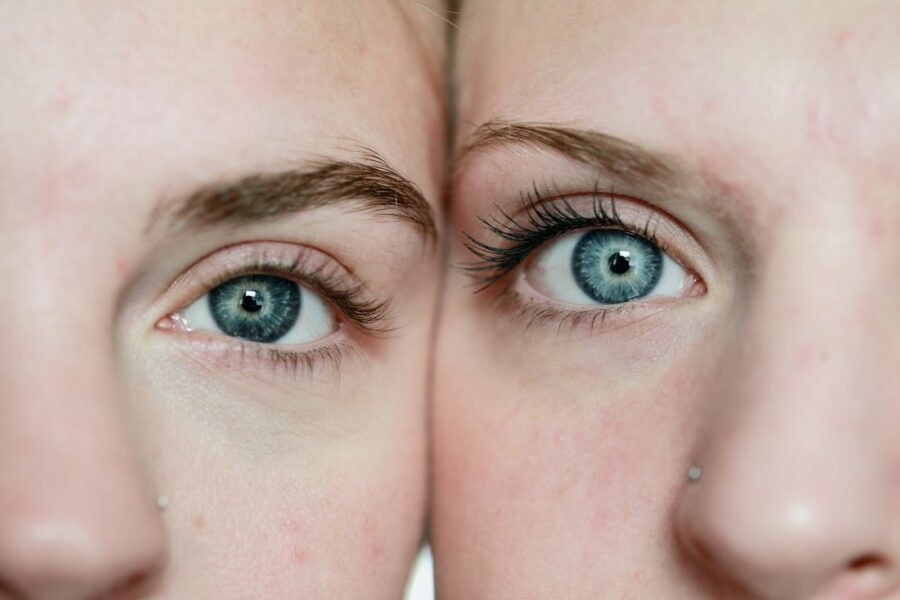Importance of eye health in the workplace
We often don’t realise how much we take for granted in our lives until something becomes remiss. Our eye health is no different! For years we just look around, see things clearly and don’t give our eyes much thought. Until we start to have a problem that is- irritable eyes, excessive blinking, tired eyes and lack of focus and clarity are all common issues people bring to the attention of their Optometrists.
The use of VDU devices in our daily lives has shown an increase in issues being presented to optometrists. When looking at a digital screen, we blink 60% less, which can destabilise the tear film, affecting comfort and vision. (1,2)
The Digital Comfort Survey, commissioned by Johnson & Johnson Vision, found that, of people in the UK who wear vision correction, 81% use five different digital screens per day and two thirds indicated that the role of screens is detrimental to their eye comfort.
Common symptoms of Digital Eye Strain are:
- Tired eyes
- Strained feeling eyes
- Blurry vision
- Dry eyes
- Headaches
- Shoulder and neck pain
Dry eyes are a common feature of increased VDU use
The more you use a VDU screen, the more you concentrate and your blink rate is reduced. Your blink rate is defined by the number of times you blink in a minute. We blink a lot less when we concentrate on something and VDU users are no exception to this rule. The reason to blink is to remove bacteria and refresh your tears- if you don’t blink for 30-40 seconds, your tears have evaporated and not been replaced with a blink, causing your eyes to feel sore, stinging and irritable.
By aged 50, the tear film of the eye breaks down 50% faster than someone under 50- this combined with increased digital device use will exacerbate the symptoms of dry eye and variable vision quality.
Many optometrists encourage the 20/20/20 rule:
Every 20 minutes, look at something 20 feet away for 20 seconds. This encourages the VDU user to look away from the screen and help relax their eye muscles.
Another great tip is to encourage a forced blink every time you press the Enter key on your keyboard- this might sound crazy but it really helps!
Constant focusing on a VDU screen causes your eye muscles to work really hard- imagine being asked to hold a cup in an outstretched arm for 30-40 minutes! Your arm muscles would be tired and your eyes are no different! Regular breaks away from your screen are hugely helpful to help your eye muscles to relax and “reset”.
Headaches are a common symptom that many digital users describe- this can only be resolved by having an eye test and seeing if you need glasses. Often your eyes are working hard all the time and glasses are needed to help your eyes relax. It’s ok to let your glasses do the hard work!
Many optometrists report from their patients that longer days in front of a digital device is causing more dry eye symptoms. More than 67% of patients report that the increased use of screen is detrimental to their eye comfort.
So how can we help our employees in the workplace?
1.Encourage the uptake of eye exams at the opticians to keep on top of eye health.
- Start implementing the 20/20/20 rule into your employees daily life.
- Provide a sticky tab reminder for your employees to stick on their ‘Space’ bar or ‘Enter’ button on their keyboard to remind them to blink! Keep those tears refreshed!
- Encourage staff to stay dehydrated and to drink plenty of water throughout the working day- note that caffeine can dehydrate you!
- Ensure the atmosphere around your employees isn’t too dry- air conditioning and heating can exacerbate dry eye symptoms. If the work environment is very dry, place a bowl of water on the floor, to help keep moisture in the atmosphere (when the water evaporates, it stays in the atmosphere, acting like a humidifier).
- Use lubricating eye drops recommended by your optometrist- they act like a moisturiser, not a medication. Once a day won’t be enough- at least 4 times a day will be needed, in order for them to make a real difference. If the eye drops you have aren’t making a difference- go back and see your optometrist and discuss other options.
- Adjust the workstation- the ideal position for a screen is at arm’s length and 45 degrees below the visual axis. Ensure that any prescription glasses that are worn are designed for your employees exact workstation set up.
- Ensure that any reflections from overhead lighting are minimised with the screen angle adjustment. Sitting next to a window can cause glare reflections on the screen- try and angle the screen away. If you can’t move the screen, have blinds that can be positioned to help reduce the glare reflections.
- Ideal lighting in your employees workplace should be no brighter than the actual screen. Ideal lighting will reduce eye fatigue.
- Invest in good ergonomic chairs for your employees- this will do wonders to ensure their neck and back are fully supported when sitting in an upright position for most of the day. Good posture will reduce neck pain and reduce the risk of headaches too.
Providing eye tests and spectacles for your employee
All employers are obliged to pay for an eye examination for their employees (provided they are full time VDU users) and if glasses are required specifically for the VDU then the employer is obliged to pay towards a basic frame and lenses. Many organisations allow their employees to go to any optician and they reimburse the cost of the eye examination. If you do have a provider in place, it would be reasonable to have more than one approved provider, to allow your employees to have a choice where they wish. Empowered employees are productive employees.
Meeting the eye health needs of employees isn’t a glamorous task nor is it often top of the list when it comes to creating the right environment to support a workforce and encourage productivity; however, it is an essential need to consider and provide for. By making simple changes to the working environment and sharing easy to action guidance with employees, employers can take charge in mitigating the effects of the working day on their employees and empowering them when it comes to their ongoing eye health.
References:
- Tsubota K, Nakamori K. Dry eyes and video display terminals. N Engl J Med. 1993;328(8):584. doi: 10.1056/NEJM199302253280817
- Patel S, Henderson R, Bradley L, et al. Effect of visual display unit use on blink rate and tear stability. Optom Vis Sci 1991;68(11):888-892. doi:1097/00006324-199111000

Harpreet Kular
Harps Kular, Director and Co-Founder of Harper & Cooper Opticians, has worked as an optometrist since 2004 and has been in the optical industry for over 24 years. Her mission in her work is to provide the highest standard of optical care whilst also helping people find fabulous eyewear that boosts confidence and empowers them.


